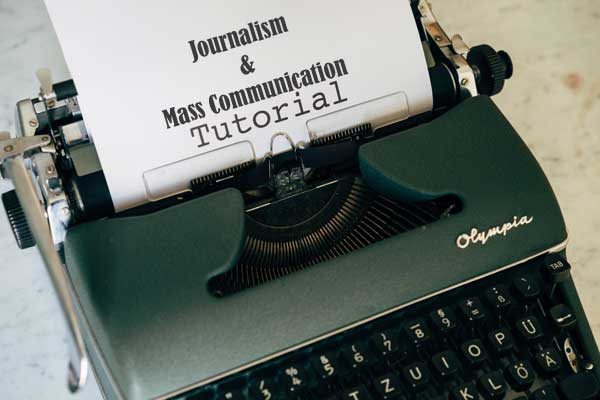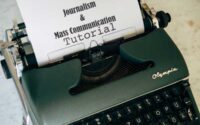Journalism Interview Questions
Aspirants can find the Journalism Interview Questions with answers here. Journalism Interview Questions for Both written examination and interview are available here. The Candidate who is appearing for Journalism can download the Interview Questions from the link given.

Journalism Interview Questions are available in our web page. However, to help the aspirants in getting their dream jobs we have given the direct download link for the Journalism Interview Questions Pdf in the section below. We advise the applicants who are in search of Journalism Interview Questions to refer the syllabus and exam pattern details.
Interview Questions on Journalism
1. Which newspaper was started as a Bengali paper but later, changed into an English paper?
(A) Indian Mirror
(B) Kesari
(C) Mirat-ul-Akhbar
(D) Amrit Bazar Patrika
2. What is CATV?
(A) Community Action Television
(B) Community Antenna Television
(C) Conduit for Antenna Television
(D) Conductor for Antenna Television
3. Multi-tasking in journalism is due to:
(A) Media globalisation
(B) Economic liberalisation
(C) Social integration
(D) Technology convergence
4. The term ‘spin doctors’ refer to:
(A) News reporters
(B) Advertisers
(C) PR professionals
(D) News editors
5. If a publication is half the size of a broadsheet, it is called:
(A) Digest
(B) Single demy
(C) Double demy
(D) Tabloid
6. When a research problem is related to a large heterogeneous population, the most suitable sampling method is:
(A) Cluster sampling
(B) Stratified sampling
(C) Convenient sampling
(D) Lottery method
7. L. A. Festinger advanced the idea of:
(A) knowledge model
(B) meaning paradigons
(C) agenda setting
(D) cognitive dissonance
8. All non-digitised media are identified as:
(A) Non-digital media
(B) Textual media
(C) Non-interactive media
(D) Analogue media
9. Redundancy helps in solving the problems associated with:
(A) Media
(B) The political system
(C) Audience
(D) Law
10. The systems theory of public relations is described as a set of united:
(A) pressure groups
(B) subsystems
(C) employee systems
(D) production systems
11. What was the name of the report of the Macbride Commission?
(A) Many Voices, Many Worlds
(B) One Voice, One World
(C) Many Voices, One World
(D) One Voice, Many Worlds
12. Who has propounded the ‘Spiral of Silence’ theory?
(A) Elizabeth Noelle Neumann
(B) Nora Quebral
(C) Marshal McLuhan
(D) Dennis McQuail
13. ‘Cinema Verite’ means:
(A) Creative interpretation of reality
(B) Type of film a documentary aims to be
(C) Quality of life
(D) Class of film
14. Which of the following Articles in the Indian constitution deals with the reasonable restrictions on freedom of speech and expression?
(A) Article 19(1) (a)
(B) Article 19(1) (b)
(C) Article 19(2)
(D) Article 19(3)
15. Semantic noise affects the understandability of:
(A) the message
(B) the medium
(C) the encoder
(D) the transmission
16. To a positivist researcher, reality is:
(A) Critical
(B) Objective
(C) Interpretative
(D) Conventional
17. In terms of public awareness, news has the status of:
(A) Dominant discourse
(B) Conflict value
(C) Limited judgement
(D) Unintended exchange
18. Hypodermic needle model was countered by:
(A) ABX model
(B) Circular model
(C) Diffusion model
(D) Limited effects model
19. Which one of the following theories believes that the mass media are used as stooges of the rich capitalists to exploit the weak poor masses?
(A) The Information Society Theory.
(B) The Marxist Theory of Media and Society.
(C) The New Normative Theory.
(D) The Agenda Setting Theory.
20. Who stated, ‘Freedom always entails an obligation, whether it is a nation’s freedom or an individual’s freedom or a group freedom of the press’?
(A) Lord Linlithgo
(B) Lord Mountbaten
(C) Dr. Rajendra Prasad
(D) Jawaharlal Nehru
| Questions and Answers | Mock Test |
| Interview Question | Sample Question |
| MCQ Objective | Model Papers |
| Question Bank | Quiz |
21. The structuralist view of the Dependency Paradigm is based on the:
(A) Research efforts of Schramm and Lerner
(B) Ideology and content of media
(C) Tenets of the alternative paradigm
(D) Premises of the dominant paradigm
22. Albert Bandura, a social psychologist, researched upon the imitation effect of:
(A) Fantasy films
(B) Reality shows
(C) Television violence
(D) Internet comedy
23. In the context of mass media effects, what is priming?
(A) People tend to associate themselves with cinema stars, who have a macho image
(B) TV and radio act as primers to perpetuate the tendency to watch movies in theatres.
(C) When people are exposed to some events through mass media, their thoughts lead to the generation of semantically related ideas and action tendencies after some time
(D) People associate the events watched, read or heard in the media to their own needs
24. Firewalls are used to protect a communication network system against:
(A) Unauthorised attacks
(B) Virus attacks
(C) Data driven attacks
(D) Fire attacks
25. A study of a specific population and its changes over a period of time is known as:
(A) Cohort analysis
(B) Demographic analysis
(C) Population analysis
(D) Cluster analysis
26. In mass communication, selective perception is dependent on the receiver’s :
(A) Competence
(B) Predisposition
(C) Receptivity
(D) ethnicity
27. According to Umberto Eco, aberrant coding takes place in a
(A) Tribal society
(B) Farming society
(C) Convergent society
(D) Mass society
28. Mass media according to Lazarsfeld and Merton, reinforce
(A) Public image
(B) Economic stability
(C) Religious participation
(D) Social norms
29. The World Press Freedom Index is released every year by which of the following organisation?
(A) Amnesty International
(B) UNICEF
(C) AEJMC
(D) Reporters Without Borders
30. Who among the following is not associated with development communication /journalism?
(A) Majid Tehranian
(B) Srinivas R. Melkote
(C) Nora Quebral
(D) Noelle Neumann
31. Multi-stage sampling is a type of
(A) Cluster sampling
(B) Random sampling
(C) Accidental sampling
(D) Innovative sampling
32. Who first propounded and used the concept of stereotypes in mass media?
(A) William Raymonds
(B) Michael Foucolt
(C) Marshal McLuhan
(D) Walter Lippman
33. When a photograph is edited to adjust the colour balance, it is called
(A) colour separation
(B) colour gradation
(C) colour correction
(D) colour editing
34. Knowledge tends to create more knowledge is the thesis behind
(A) the circular model
(B) the helical model
(C) the spiral of silence model
(D) ABX model
35. The phrase ‘people’s right to know’ was coined by whom?
(A) Harold Cross
(B) Kent Cooper
(C) Elie Abel
(D) William Rivers
36. Who was the first person to use ‘gatekeeping’ in communication?
(A) Kurt Lewin
(B) Ralph Webb
(C) J. E. Walsh
(D) George Gerbner
37. The use of social science scientific research methods in journalism is known as
(A) armchair journalism
(B) analytical journalism
(C) precision journalism
(D) sting journalism
38. The utilisation of personal space and physical environment for communication is known as
(A) Kinesics
(B) Para-language
(C) Chronemics
(D) Proxemics
39. A television programme becomes a text when it activates
(A) profit motive
(B) meanings
(C) producers
(D) channels
40. ‘The Bias Communication’ is authored by whom?
(A) Marshal McLuhan
(B) Harold Adams Innis
(C) John Fiske
(D) Theodore Adorno
41. The multiplicity model of developmental communication was advocated by
(A) Jan Servaes
(B) Lucien Pye
(C) Shirley White
(D) Bella Mody
42. Duplicating only the sampling and experimental procedures of a previous analysis is called
(A) Literal replication
(B) Instrumental replication
(C) Constructive replication
(D) Operational replication
43. The ‘airwaves are public property’ is a declaration of
(A) I T U
(B) Supreme Court of India
(C) Prasar Bharati
(D) Ministry of I and B, Govt. of India
44. The theory of ‘brand image’ was propounded by
(A) Samuel Black
(B) Philip Kotler
(C) Ivy Lee
(D) David Ogilvy
45. Identity the author of the book ‘Rise of Network Society’ from the following.
(A) Rupert Murdoch
(B) Bill Gates
(C) Manuel Castells
(D) Steve Jobs
46. Raymond Williams identified the general process of meaning production in relation to
(A) Ideology
(B) Publicity
(C) Advertising
(D) Public relations
47. Democratic participant theory of media can be implemented only by
(A) citizen viewpoints
(B) cultural autonomy
(C) decree
(D) public administration
48. Publishing or telecasting controversial advertisements is a
(A) PR tactic
(B) political stunt
(C) non-commercial strategy
(D) mindless act
49. Assertion (A) : Most television channels depend upon national advertising for their survival.
Reason (R) : It is cheaper to advertise on television as it reaches specific audiences.
(A) Both (A) and (R) are true
(B) Both (A) and (R) are true, but (R) is not the correct explanation of (A)
(C) (A) is true, but (R) is false
(D) (A) is false but (R) is true
50. Assertion (A) : The obsession of Indian Print media for politics is a historical legacy.
Reason (R) : Because many political leaders were associated with newspapers to advocate the cause of freedom before 1947.
(A) Both (A) and (R) are true.
(B) Both (A) and (R) are true but (R) is not the correct explanation of (A).
(C) (A) is true but (R) is false.
(D) (A) is false but (R) is true.

